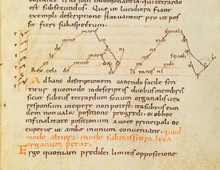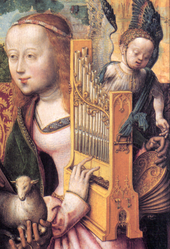Hymnody of continental Europe
Among the earliest surviving Christian songs include those described in the New Testament traditional canticles as the Benedictus, the Magnificat and the Nunc dimittis.
[2] Literary criticism makes it possible, on the basis of stylistic criteria, to elaborate Christ songs and liturgically used portions in the New Testament.
Criteria: Probably the earliest evidence for liturgical hymns outside of the New Testament can be found in the letters of Ignatius of Antioch in his Epistle to the Ephesians (7, 2 and 19, 2f).
[5] In the fourth century, leading church fathers gave great prominence to parish singing: in the East, there were transformations of the liturgy under Basil of Caesarea.
In the West, Bishop Ambrose of Milan made liturgical and musical reforms and the introduction of Ambrosian hymns still sung today.
Presumably in the context of these reforms began over several hundred years continued order, collection and standardization of the melodies and texts used in the liturgy.
Although many were authored anonymously, notable sequence writers include Notker the Stammerer, Fulbert of Chartres, Hermann of Reichenau, and Adam of Saint Victor.
Another ninth-century development was the rhythmical office, and it was around this time in the East that idiomelon (a type of sticheron) began to be written down with musical notation.
Some of his hymns, such as "Gott sei gelobet und gebenedeiet" ("O Lord, We Praise Thee"), "Nun bitten wir den Heiligen Geist" ("We Now Implore God the Holy Ghost"), "Christ ist erstanden" ("Christ the Lord is Risen Again"), and "Mitten wir im Leben sind" ("In Midst of Earthly Life") were based on a medieval leise, which Luther reworked and expanded.
He put communal singing again under strict musical and lyrical conditions, now called exclusive psalmody: In this framework, a series of psalm songs emerged, with simple melodies that usually avoided jumps (example: get up in your power, God ).
Sigmund Hemmel set to music in the Württemberg Reformation, first around 1560 the entire Psalter for four voices in German psalm seals of various authors.
Particularly noteworthy is the first printed in 1564 Anabaptist hymn book Ausbund, which was used until the 19th century in southern German Mennonites and even today in the Amish in North America.
The core of the hymn book was 51 songs whose authorship is unknown save that they were all written between 1535 and 1540 by Anabaptists in the dungeon of the Veste Oberhaus castle.
Martin Opitz set up laws for German poetry in his Buch von der Deutschen Poeterey in 1624, which were widely adopted by German speaking hymn writers during following hundred years: One important themes in hymns at the time of the Thirty Years' War was the juxtaposition of transience and eternity.
His songs, to a large extent devotional in character, are still sung today in the services of various denominations and have been translated into numerous languages.
Pietism began as an intra-church reform movement, which wanted to break the rationalization of theology, perceived as paralyzed ( from the head to the heart ) and opposed it to a practice of faith based on personal conversion and emotional piety.
After official rejection, Pietism quickly found its place in private homes, where the pietistic hymn was of central importance.
The new songs were mostly subjective in emphasis, characterized by linguistic images in which descriptions of personal feelings stood foremost and in front of clear theological expression.
During this time, people started smoothing out the strictly metered rhythmic hymn tunes to produce to isorhythmic versions.
From about 1730, the Age of Enlightenment, which understood critical reason as the supreme principle and rejected every belief in revelation and miracles, became decisive for the theology and practice of the official churches in German – speaking countries.
God was portrayed as the loving Father and initial Creator whose world is now moving according to their own laws; Christ has been reduced to a role as a wise virtue teacher.
So many existing songs were no longer acceptable due to their textual content and were revised according to rationalistic standards of value, sometimes profoundly changed.
As of 2004 only some of these rationalistic church lyrics are sung in Germany, including the poetry of the Enlightenment theologian Christian Fürchtegott Gellert (1715–1769).
The design of new hymn tunes was no longer understood as artistically demanding; Thus, the newly created melodies have no rhythmic variety, and they often lack melodic momentum.
Matthias Jorissen's Neue Bereimung der Psalmen, published in 1798, replaced the psalm settings of Ambrosius Lobwasser in the German-speaking Reformed churches.
Some German-speaking hymn writers of the 18th and early 19th centuries attempted to mediate between the polarization of pietism and mysticism on the one hand and rationalism on the other.
These include Friedrich Gottlieb Klopstock (1724–1803), who wrote "Die ihr Christi Jünger seid" and "Herr, du wollst uns vorbereiten" and Matthias Claudius, writer of the poem "Wir pflügen und wir streuen" which was translated as the Thanksgiving hymn "We Plough the Fields and Scatter".
Today lyrics from the 19th century are to a great extent derived from Protestant theologians or clerics from the context of various German revivalist movements.
Some outstanding German literary figures and publicists of the 19th century have written individual sacred texts, which represent only a small part of a much larger work.
Important translators of hymns into German were: Baptist and Methodist hymn writers influential in German hymnody include Philip Bickel (1829–1914) ("Reicht euch die Hände, die Stunde zerrinnen," melody by Fritz Liebig) and Hans Jakob Breiter (1845–1893) ("Daheim, o welch ein schönes Wort" and "Eine Botschaft voll Erbarmen").







